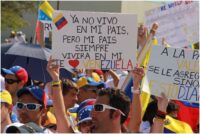
Since the beginning of human history and due to a huge variety of reasons, people have always been moving from one place to another looking for better living conditions or, sadly, just to survive. Indeed, for a long time, many tribal populations remained substantially nomadic or, more generally, mobile because their lives were inextricably linked to agriculture, pastoralism, or fishing, and the subsequent appropriation of new resources and lands. Nowadays, despite the massive improvements in the living conditions for billions of human beings, we are witnessing more migratory phenomena than in other eras. Most of the time people, as individuals or in groups, choose, forcibly or autonomously, to leave their own hometowns and countries mainly because of economic, political, and social aspects: poverty, conflicts, scarce resources, environmental problems, political threats – to mention a few.
One of the most dramatic diaspora phenomenon and current humanitarian crises is that of ethnic Venezuelans. Before explaining the reasons behind this issue, it is important to highlight the sharp reversal of their fortune over the last 40 years. The country was in fact the wealthiest one in the Latin American continent, predominantly thanks to its natural resources, and it was considered a safe place of hope and prosperity for millions of European and South American immigrants. As reported by the 2011 Census carried out by the Venezuelan National Institute of Statistics, the country presented itself as a multi-ethnic, pluricultural, and multilingual entity. However, political unrest and poor management of the country’s oil industry have hampered its production and, consequently, have deteriorated the majority of citizens’ living conditions. A staggering ambiguous question arises: how is it possible that the country which owns the world’s largest oil reserves (in 2019, 17.5% of the world’s total was located in Venezuela, but it’s not even on the list of top ten oil producers) is at the same time witnessing an exponential and uncontrolled growth of people leaving their hometowns?
The Venezuelan diaspora has suddenly become one of the largest displacements and humanitarian crises in the world. According to official data provided by the Regional Inter-Agency Coordination Platform (R4V), in March 2021, the number of Venezuelan refugees, migrants, and asylum seekers has officially reached the threshold of 5.5 million, of an estimated total population of 32 million people. Venezuelans have mostly fled to other countries in the American continent but also to Europe, as well as to other developed countries all around the world. The top ten destinations for Venezuelan emigrants are Colombia, Peru, the United States, Spain, Italy, Portugal, Argentina, Canada, France, and Panama. Furthermore, between 2015 and 2017, the emigration trend increased by 1,388 percent in Chile, 1,132 percent in Colombia, 1,016 percent in Peru, 922 percent in Brazil, 344 percent in Argentina and Ecuador, 268 percent in Panama, 225 percent in Uruguay, 104 percent in Mexico, 38 percent in Costa Rica, 26 percent in Spain, and 14 percent in the United States. However, these figures represent just an estimation and they are supposed to be much higher as the data gathered comes from the host governments, which use different methods of statistical data processing and collection.
It all started moderately in the aftermath of the presidential election of the leftist firebrand Hugo Chávez in 1999, who wanted to break the country’s economic elite and redistribute wealth to the poor, but in that occasion, those who were fleeing to more welcoming countries hailed from the rich and middle classes. Besides, the country was marked by diffused corruption and rampant crime which have, since then, subjected it to strenuous periods of political instability and violence, socio-economic insecurity, as well as lack of food, medicine, and essential services. The 2008 global economic crisis, in addition to the controversial election of Nicolás Maduro in 2013, has worsened things further, driving the country to the attainment of a breaking point: oil prices fell drastically, economic mismanagement led to the world’s highest inflation rate, poverty and malnutrition rates boosted. Simultaneously, “Maduro’s government has jailed and allegedly tortured opponents, sparking a wave of political asylum seekers”.
According to the International Organisation for Migration (IOM), thousands of Venezuelans cross over to the neighbouring South American countries on foot (the so-called “caminantes”, the Spanish word for “walkers”) – probably without knowing their final destination. Many others take the sea route because of the short distance to the Caribbean islands, sometimes putting their lives at risk and at other times,braving the clutches of the smugglers and traffickers. Thankfully, the countries in the region have generously opened their doors to the high number of refugees and migrants, providing them with access to basic needs such as shelter, food, healthcare, education, and even employment.
However, the wave of solidarity and hospitality did not last for a long time. Another drastic change has occurred in the past few years. It seems that the initial welcome and help provided by the neighboring countries in assisting Venezuelan refugees and migrants has drawn to an end. It looks like a re-enactment of the massive scale of the Syrian exodus into Western Europe in 2015, and, just as in that crisis, countries overwhelmed by the flood of new arrivals are closing their borders and making settlement visa applications more difficult to obtain. Moreover, Venezuela now ranks second, only after Syria, for countries with forcibly displaced populations.

For instance, Venezuelan migrants in Panama have been involved in numerous investment ventures and have taken advantage of business opportunities in the construction business, restaurants, franchises, and real estate. But, in October 2018, Panama imposed new visa requirements on Venezuelans, making it far more difficult for economic migrants and asylum seekers to enter the country, and many Venezuelans were increasingly expelled or agreed to return to their countries: in January 2018 alone, 308 people were deported; while from 2010 to 2016, Panama deported only 196 Venezuelans in total, according to government statistics. Marco Ardon, a former business owner in Venezuela now working in a Panama City coffee shop, declared: “We’ve been coming here en masse, like people fleeing from a war zone. You’re on the bus and you hear people speaking with a Venezuelan accent everywhere now. You feel like [Panamanian] people don’t like it, that we’re too many here.”Recently a new wave of migrants has reached the country which many Panamanians interpret as an invasion. So, for the first time in history, different demonstrations against Venezuelan immigrants have started to grow like mushrooms, including social media slogans such as“Panama for Panamanians”, or flyer prefacing, in a derogative and stereotypical way, references to popular Venezuelan dishes: “No more arepas” (the typical cornbread), “no more tequeños” (a classic party snack).
Despite the increasing feeling of discrimination and racism among host countries’ citizens, many governments in Latin America and the Caribbean have continued to show great solidarity towards Venezuelans and to facilitate their access to basic rights and lifesaving services, supporting their integration. This is especially true with regard to the devastating and ongoing socioeconomic and human impact of the COVID-19pandemic, which has affected the host countries but also, to a higher degree, the already precarious situation of many Venezuelan refugees and migrants. As acknowledged by the researcher Veronica Escobar Olivo, “a number of refugees have sought to return to Venezuela, hoping that coping with the pandemic will be more comfortable there. Upon arrival in Venezuela, however, returning refugees are being locked up in border towns, to be forced into unsanitary quarantines by officials”. Although international aid is limited, many organizations such as Médecins Sans Frontières (MSF) have been putting in place many efforts to help Venezuelan authorities improve sanitation facilities in the refugee camps: systems for gathering clean water, water purification resources, showers, bathrooms have been installed.
The future of Venezuelans remains as uncertain as dramatic, just as Venezuela remains in a complex situation of political and economic stalemate. For this reason, the international community, in partnership with local NGOs and national governments, has to find as soon as possible a harmonized and coordinated operational response to ensure that the highly vulnerable Venezuelan migrant populations are not left behind. There is an urgent need to boost the support for humanitarian protection and integration programs on which the lives of millions of people depend, including that of host communities. As established and recommended by the 2020 IOM Regional Response Report, “while each country faces distinct challenges, there is an overall need to support governments in this new phase of migration outflows as well as in continuing to strengthen a regional inter-agency approach to the multi-dimensional aspects of this crisis”.

Fabrizio Parrilli, 24, Master’s degree Student of International Cooperation on Human Rights at the University of Bologna, Italy. My areas of interest are mainly focused on international issues, contemporary history, protection of human rights, political and cultural dynamics. I love traveling, discovering new cultures and having fun. My motto is live, love, laugh.
